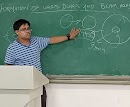Speed of light has been broken: Cutting-edge discovery in Plasma Physics
Speed of light, a constant and we all know that. The constancy of the speed of light in a vacuum is a postulate in the Special and General Theory of Relativity. Along with that, we can also calculate the exact figure of the speed of light in a vacuum using laws of electromagnetism and that figure is exactly 299,792 km/sec.
People always wondered
and asked that whether is it possible to break the speed of light and now we are
in the position to answer this question.
The breakthrough
discovery was done by the researchers from Lawrence Livermore National
Laboratory in California, USA and the University of Rochester in New York, USA.
Don’t get me wrong,
light has a constant speed limit but under certain conditions, this can be
broken for individual pulses of light. The researchers did the same thing.
To achieve this feat,
they used plasma, the fourth state of matter. Plasma consists of a gas of ions.
Ions are basically particles, atoms or molecules with a net electric charge. A
common example of plasma is lightning. But it also can be artificially generated
by heating a neutral gas or subjecting it to a strong electromagnetic field. A
common example of its application is Neon light that we use for decoration and
lighting purposes.
As we all know, the speed
of pulses of light can be vastly different in different mediums and not the same as
the speed of light in a vacuum. For example, the speed of light is slower in
water as compared to vacuum. The maximum speed of light which we can observe was the
speed of same in a vacuum and this has been broken in this experiment.
In this experiment,
the scientists firstly created a hydrogen-helium plasma by ionizing a jet of the
gas with a polarized laser beam.
I am not going too deep into the theory polarization but for the sake of understanding this experiment, I am giving an overall idea of it in simple terms. Normally, when a light beam travels, it has light waves at different planes and they have different angles with each other. So, to get only one specific plane we use a method named as Polarization, where, a device named a polarizer has a thin and closely situated long chain of molecules to filer out a specific plane of light.
 |
| Example of Polarization. 1)Light Source 2)Unpolarized Light with all of its planes 3)Verticle Polarizer 4)Verticle Polarized light |
After doing all these,
they aimed a second laser beam at the plasma and where the two beams crossed, a
peculiar thing happened, the horizontal component of the second laser beam slowed
down as compared to the earlier state. Now, as I said earlier that a specific beam
of light may have multiple planes at various angles to each other, so there is
also one horizontal plane or component and one vertical plane or component. So,
in this case, the horizontal component slowed down and it happened because of the
interaction between the two lasers and the plasma.
Now, when they measured
the time delay between the horizontal and vertical components of the second laser
pulse, then they observed that they had a different speed and by tuning the
frequency (inverse of time) difference between the two beams, they found that
the speed can be tuned from 0.995c to between 0.12c and -0.34c and by this way
my friend, they found out that the pulse travelled faster than c.
Fascinating right???
But after all these,
you might be thinking that how photons, that is, the quanta of light are
travelling faster than the speed of light?
Well, it’s a classic
mistake. Notice carefully that at the beginning I warned you about this fallacy
and told you that its not the photon which is travelling faster than the speed
of light, rather its pulses. The velocity of pulses, which is technically
called group velocity, can vastly differ from the speed of light travels in
a vacuum. Photons are nothing but the effect of electromagnetic field according
to Quantum Field Theory (QFT) and Quantum Electrodynamics. So, it’s the electromagnetic
field wave for which the phenomenon of light happens. So, the speed of that
wave is c when it travels through a vacuum and the pulses of light made by it
can be changed in various mediums due to different group velocities. For example,
it slows down in medium like water. Just like that, the group velocity is
increased in the plasma medium.
Applications
From an application
point of view, this experiment will significantly increase our knowledge in the
space of plasma physics. Moreover, the experiment will also lead to significant
improvements in the field of laser technology, which until now, mostly rely on solid-state
physics and optical materials for practical applications.
Using plasma to amplify or change light characteristics will help us to create evermore powerful lasers which can be used in applications like particle accelerators and fusion tech.
For those who want to
read the research paper on this experiment, click here.
Thanks for Reading!!!
-Ratnadeep Das Choudhury













0 Comments